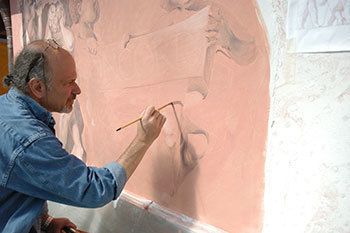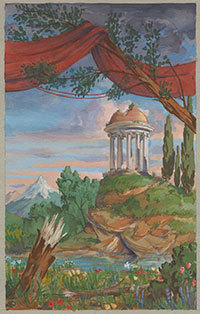
During the Renaissance period, it was common for architects also to be painters — a natural integration of two sets of skills, both of which create an experience with space.
“In the Renaissance, painting and architecture were viewed as intellectual exercises. The intuitive brain-hand dynamic facilitated thinking, and the main skill painters brought to the table was perspective,” says David Mayernik, a University of Notre Dame associate professor of architecture and practicing architect who is among a just a handful of contemporary architects who also apply their artistic talents to the theater.
Mayernik recently served as set designer for the baroque opera “La Déscente d’Orphée aux Enfers,” a 17th-century love story in which Orpheus rescues his bride, Eurydice, from the underworld through his musical gifts. It was produced by the Haymarket Opera Company in Chicago.
The architectural vision has been essential to the illusionism of stage design for hundreds of years, and architects as painters can be considered illusionists who create a fictional world.
“This is not just providing a background,” Mayernik explains of his design for the opera. “The audience can ‘read’ the pictures as a supplement to the story.”
In his recent design for the opera, Mayernik created scenes depicting both an “upper world” that appears as a classical landscape — but with hints of danger and ruin; and an “underworld,” a torturous inversion of the upper-world, echoing and amplifying the danger.

Symbolic architecture, such as memorials or government buildings, are laden with meaning, similar to the storytelling in opera set design — both require thinking both temporally and metaphorically.
“Classical art and architecture are languages, and in the Renaissance tradition they were rhetorical. Paintings and buildings were articulate, able to tell stories, project messages, and in general speak for their societies’ aspirations,” says Mayernik.
As a practicing urban designer, architect and writer, Mayernik’s role as set designer is a natural extension of his talents: He also is a painter in oil, buon fresco and watercolor; he studied fresco with renowned restorer Leonetto Tintori in Tuscany, and has painted frescoes for his own buildings in Switzerland and for churches there and in Italy. His book, “Timeless Cities: An Architect’s Reflections on Renaissance Italy,” describes how cities were articulate of their societies’ aspirations.
Before teaching at Notre Dame’s main campus and in Rome, Mayernik taught in the Graduate Fine Art program of the New York Academy of Art, the Institute for the Study of Classical Architecture, and at the University of Virginia’s Erasmus-Jefferson Scholars Summer in Tuscany program. His drawings have been exhibited internationally, and his work has been featured twice in “American Artist” magazines.